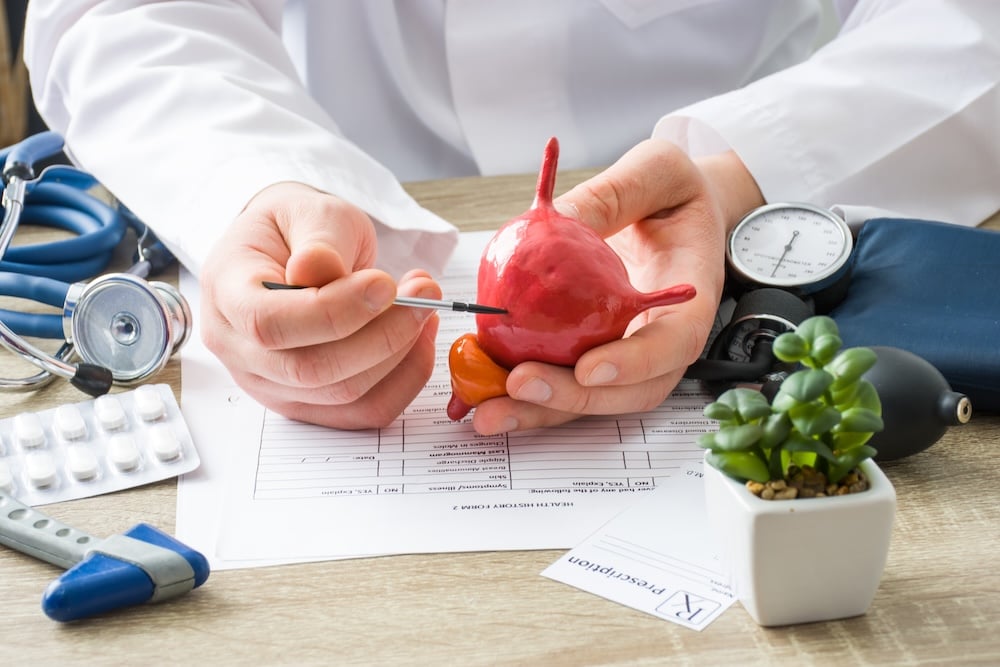4 Things You Need to Know About Bladder Cancer
5 min read

Bladder cancer occurs when cells in the bladder begin to grow uncontrollably. There is no official screening program for bladder cancer, which means you have to rely on noticing symptoms, which can be subtle.
It’s also good to know if you’re at an above-average risk for developing bladder cancer based on your age, gender, and certain lifestyle choices. That way, you can be even more aware of the signs and seek medical attention quickly if you notice anything out of the ordinary.
Let’s look at four important things you should know about bladder cancer.
1. Early Symptoms of Bladder Cancer Are Easy to Miss
Bladder cancer usually goes undetected for a while, and when it starts to show signs, they could be easy to overlook. That’s because bladder cancer symptoms often resemble other common urinary issues.
The most common first sign of bladder cancer is blood in the urine. However, other symptoms like frequent urination, urgency to urinate, and pelvic discomfort aren't usually as alarming because they can be associated with conditions such as urinary tract infections (UTIs), overactive bladder, or kidney stones.
If you experience any of these symptoms, particularly blood in the urine, it's best not to ignore them. Instead, schedule an appointment with your primary care physician or a urologist for an examination to rule out any serious issues. While several of these symptoms could be the result of something else, they may also indicate a bigger problem, such as bladder cancer.
Related blog: Bladder Cancer Symptoms and Diagnosis: What You Should Know
2. Smoking is the Leading Cause of Bladder Cancer
Most people are aware that smoking is the leading cause of lung cancer, but it is also the primary cause of bladder cancer. Just as the harmful chemicals in tobacco damage the lungs, they can also lead to inflammation and other damaging effects on the bladder lining. Since the main function of the urinary system is to filter waste from the body, it's clear to see how smoking significantly contributes to an increased risk of bladder cancer. The toxins from smoking remain in the bladder for an extended period until you are ready to urinate.
According to the American Cancer Society, smokers are at least three times more likely to get bladder cancer compared to non-smokers, and about half of all bladder cancers are linked to tobacco use. If you smoke and need help with quitting, consider reaching out to the Colorado QuitLine.
3. Bladder Cancer Can Be Misdiagnosed – Especially in Women
Even though bladder cancer is four times more common in men than in women, it’s easier for women to mistake a symptom, such as seeing blood when going to the bathroom, as a menstrual or gynecologic issue. Women are also more likely to have a urinary tract infection (UTI) that can cause blood to appear in the urine. If you’ve had a UTI with blood before, you might assume that’s what it is.
It’s important that you don’t ignore blood in the urine or pelvic pain. In many cases, there is a simple solution to an infection causing the symptoms. Ignoring it and assuming it’s nothing can result in delayed detection of bladder cancer, sometimes, when it has already progressed to a more advanced and harder-to-treat stage.
If you notice that something doesn’t feel right, and testing shows no signs of a UTI, it’s a good idea to go to a urologist who can further evaluate your symptoms.
Learn more about how bladder cancer is diagnosed.
4. Bladder Cancer Treatment Varies Depending on Stage and Type
The recommended treatment plan for bladder cancer depends on several factors. One of the most important is whether the cancer has invaded the muscle wall of the bladder. The size of the tumor and whether it’s muscle invasive are the first things the urologist and oncologist will look at. To understand the extent of the tumor, a transurethral resection of bladder tumor (TURBT) is usually performed by the urologist to better understand how much cancer is in the bladder and how far it has grown into the muscle, if at all.
Non-muscle-invasive bladder cancer treatments
When caught early, before the cancer invades the bladder's muscle layer, it is usually removed with a TURBT surgery and may be followed by intravesical therapy. A liquid drug is placed directly into the bladder to target cancer cells in the bladder lining. A common option is Bacillus Calmette-Guérin (BCG), a therapeutic immunotherapy cancer vaccine. If BCG is ineffective, intravesical chemotherapy drugs such as gemcitabine and mitomycin may be used.
Muscle-invasive bladder cancer treatments
For tumors that have invaded deeper into the bladder's muscle wall (muscle-invasive), a TURBT may be used to diagnose and then to remove the cancer. If all of the tumor cannot be removed with a TURBT procedure, a different surgical procedure called a cystectomy may be necessary to remove the bladder.
Depending on the specific diagnosis, your oncologist will recommend additional treatments for bladder cancer, which can include:
- Systemic chemotherapy: This type of chemotherapy enters the bloodstream, allowing it to reach cancer cells throughout the body. A combination of several drugs may be needed, especially for more advanced bladder cancer.
- Immunotherapy: A class of immunotherapy drugs known as immune checkpoint inhibitors may be given to help boost your body's immune response against cancer cells. Most patients receive this after surgery and chemotherapy if any sign of cancer remains.
- Radiation therapy: Some patients may receive radiation therapy along with chemotherapy (chemoradiation) at different stages of their treatment.
- Targeted therapy: Bladder cancer tumors with mutations in FGFR genes may benefit from drugs known as FGFR inhibitors, which specifically target these mutations.
Bladder cancer has a high recurrence rate, so regardless of what treatments you receive, your oncologist will want to monitor you closely. Regular follow-ups will help your bladder cancer specialist watch for signs of any new cancers.
Importance of Early Detection for Bladder Cancer
Early detection of cancer often leads to more treatment options and better outcomes. Currently, there is no standard screening for bladder cancer, but you can still be aware and vigilant about your health.
If you notice any unusual urinary habits, make sure to schedule an appointment with your doctor, especially if these symptoms are persistent. While it doesn't necessarily mean you have cancer, it's best to rule it out.
Bladder Cancer Treatment in Colorado
If you were diagnosed with bladder cancer, we encourage you to request an initial consultation with one of our bladder cancer doctors. The multi-disciplinary team at Rocky Mountain Cancer Centers has helped thousands of patients over three decades navigate their bladder cancer diagnosis with expert care and compassionate support.
From diagnosis through treatment and survivorship, our team is here to answer your questions, explain your options, and help you feel more in control. We are also available for a second opinion consultation. We are located throughout the Denver metro area, Colorado Springs, and Boulder.

